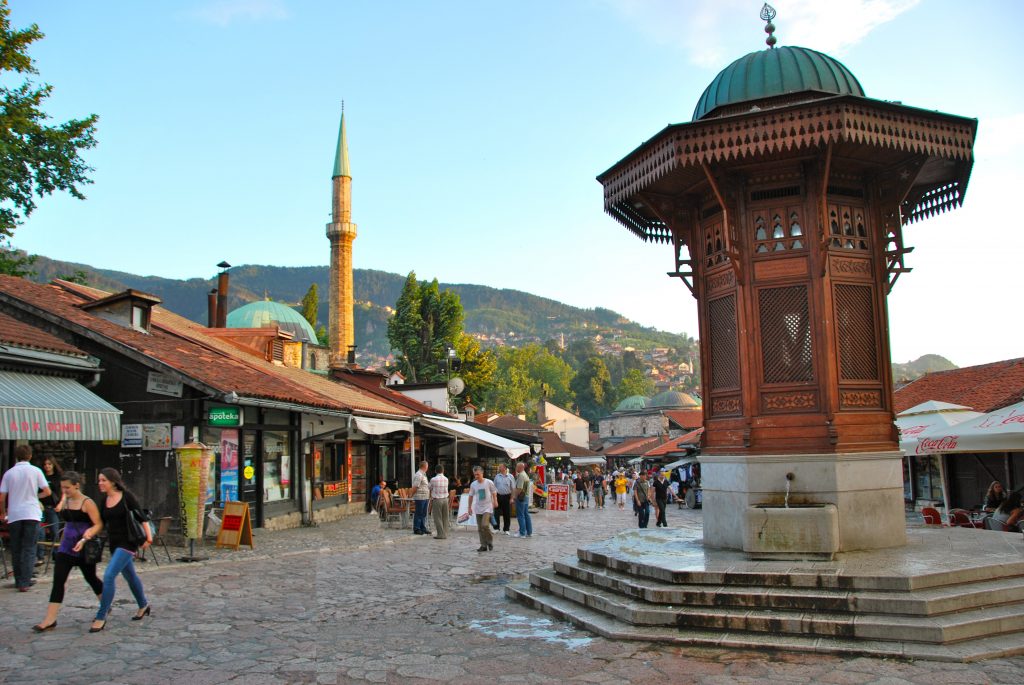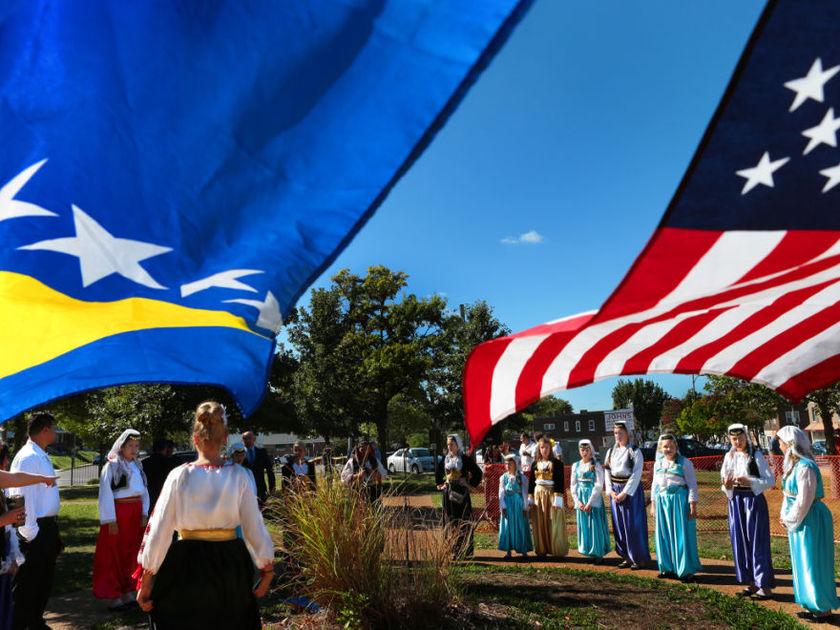Bosnia & Herzegovina – A Cultural Guide
Jin Kong is a guest research fellow with The Greater Cincinnati World Affairs Council (GCWAC) for the next six months. This fellowship is sponsored by The Mission Continues. Through this fellowship, Kong is researching to gain a better understanding of the populist sentiment towards immigrants in the Cincinnati region. This is one blog of many on his research of immigration and Cincinnati. To learn more about Jin Kong click here.
Bosnia & Herzegovina:
History and Government
The modern-day Bosnia and Herzegovina nation is located in the western Balkans. It neighbors Croatia, Serbia, and Montenegro. Historically, the region was inhabited by a heterogenous group of Indo-European tribes loosely identified as Illyrians. It was once thought the Illyrians migrated into the region from northern Europe during the Iron Age; but more recent findings suggest proto-Illyrians, or nomadic Indo-Europeans, had arrived in the region as early as the Bronze Age.
The region was once occupied by the Roman Empire during the 2nd and 1st century BCE. It had been part of the Roman province of Dalmatia. The invading Germanic Goths defeated the Roman armies in the 5th century, and they were then driven out by emperor Justinian I and became part of the Byzantine Empire in the early 6th century CE.
Slavs settled into the region between the 6th and 7th century, The Croat tribe settled mostly into the central, western, and northern parts of the modern-day Bosnia; while the Serb tribe settled mostly into the Drina River valley and modern-day Herzegovina. The first written account of “Bosnia” was said to have been recorded in the 10th century during the reign of Byzantine emperor Constantine VII Porphyrogenitus. “Bosona” was described by the emperor as a district centering on the Bosna River.
In much of the 11th and 12th centuries, Bosona existed as its independent state and was ruled by the Byzantium through Croatian or Serbian intermediaries; but due to its isolation from the Roman Catholic Church, the Bosnian Church developed its own distinct identity during this era. Eventually in the late 1300’s the region was annexed by the Ottoman Empire. Along with Ottoman’s dominion of the region, a shift of culture and beliefs occurred. Today, this is evident from a mix of religious architecture throughout the country.
With the decline of the Ottoman Empire, the Slavs of the region (including Bosnia, Croatia, and Serbia) rose against the Turks. After WWI, Bosnia was annexed as part of Yugoslavia in 1929. Ethnic cleansing and resistance movements took place thereafter and eventually resulted in a republic and came under communist rule by Josip Broz Tito. Between 1989 and 1992, communist rule weakened and the region saw the independence of Slovenia and Croatia; which resulted in the Bosnian War that lasted until the mid-1990’s.
Bosnia and Herzegovina declared its independence from the former Yugoslavia on 3 March 1992. On 21 November 1995, in Dayton, Ohio, a peace agreement was reached (the final agreement was signed in Paris on 14 December 1995). The Dayton Peace Accords created a multiethnic and democratic government with a second tier composed of Bosniak-Bosnian Croat Federation of Bosnia and Herzegovina and the predominantly Bosnian Serb-led Republika Srpska. A NATO peacekeeping force was eventually succeeded by a stabilization force, which was replaced by European Union peacekeeping troops in 2004. Currently, there are around 600 troops in theater in a security assistance and training capacity in Bosnia.
People and Culture
The people of Bosnia and Herzegovina are of Bosniaks Serbs and Croats. Approximately half the population are Muslims; about 30% belong to the Orthodox Church and 15% are Roman Catholics. There is also a small Jewish population.
People of Bosnia and Herzegovina are known to be hospitable. Coffee, baklava or tulumba are often offered at home upon invitation and it is rude to refuse such an invitation. Almost half of the population lives in urban settings. Sarajevo is the capital and the largest city in Bosnia and Herzegovina, and it was the site of the 1984 Winter Olympics.
Due to its long-occupied history, Bosnia and Herzegovina is the home of many mosques, Orthodox churches, cathedral and synagogues. Cultural symbols include historic Old Mostar Bridge and stone tombstones (stecci).
Bosnian food is a mix of Turkish and Eastern European cuisine. Grilled meat and cabbage stews are popular; lamb sausages are favorite with flat breads. Pastries can be found both sweet and savory; and Turkish coffee, kefir yogurt drink, salep (milk and orchid based tea), and homemade brandy are often the drinks offered. But due to the heavy Muslim influence, alcoholic drinks are prohibited in some areas.
Bosnian literature traditionally involves epics set to music passed orally from generation to generation. Modern literature is mostly about history and identity politics. Ivo Andric, raised in Bosnia as a Serbian Catholic, won the Nobel Prize in 1961 for his novel Bridge Over the Drina.

Sarajevo is well known for its rugs and carpets heavily influenced by the Turkish bright colors and geometric designs. Calligraphy and metalwork reflects traditional Islamic influence; silk embroidery is popular as well. Modern artistry sometimes invokes powerful statements with bullets, shrapnel, broken glass, ask, and other war debris.
Immigration
Bosnians began to immigrate to North American around the 1900’s. A flood of refugees came in the early 1990’s as the result of civil war following the breakup of Yugoslavia. In the 2000 US census, approximately 100,000 Americans claimed Bosniaks descent.
The earliest Bosnian immigrants came to Chicago, Detroit, and other northern industrial cities. The influx after 1992 led to settlements in New York, Missouri, Ohio, and Utah. The largest Bosnian community in the United States is in St. Louis, which boasts its own “Little Bosnia.”

Ohio is the home to some 30,000 Yugoslavians in the 1920s. Most settled in Cleveland and worked in factories or as day laborers. There is no precise census of Bosnian immigrants living in Cincinnati. In 1996, the Cincinnati Enquirer noted a non-profit organization based in Northern Kentucky, Project Shelter that brought 30 Bosnian children to Cincinnati high schools for a year; about half of them came from Sarajevo. Many of the children adapted to the American way of life quickly; “we like movies, we hate some teachers, we’re just like other kids,” said one Bosnian student. But what marked them different from their Cincinnati friends forever is their memories of war.
Reflecting on the experience of hosting a Bosnian student for a year, one Cincinnati parent told the Enquirer: “My children have been exposed firsthand to information about the war, about another culture, but they also got to know Maya herself, the individual, who is in so many ways a very special, intelligent, sensitive person.”

The blog is in part of the Mission Continues blog series, written by Jin Kong and therefore all words and thoughts are his own and not a reflection of GCWAC.


